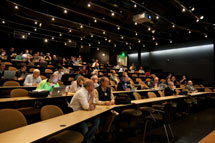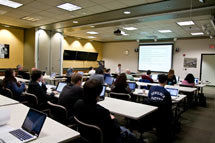
Handy Links
SLAC News Center
SLAC Today
- Subscribe
- Archives: Feb 2006-May 20, 2011
- Archives: May 23, 2011 and later
- Submit Feedback or Story Ideas
- About SLAC Today
SLAC News
Lab News
- Interactions
- Lightsources.org
- ILC NewsLine
- Int'l Science Grid This Week
- Fermilab Today
- Berkeley Lab News
- @brookhaven TODAY
- DOE Pulse
- CERN Courier
- DESY inForm
- US / LHC
SLAC Links
- Emergency
- Safety
- Policy Repository
- Site Entry Form

- Site Maps
- M & O Review
- Computing Status & Calendar
- SLAC Colloquium
- SLACspeak
- SLACspace
- SLAC Logo
- Café Menu
- Flea Market
- Web E-mail
- Marguerite Shuttle
- Discount Commuter Passes
-
Award Reporting Form
- SPIRES
- SciDoc
- Activity Groups
- Library
Stanford
Around the Bay
BaBar Collaboration Furthers Data Analysis, Anticipates SuperB
Over the past ten days, BaBar collaborators from around the world gathered at SLAC for two events. A BaBar collaboration meeting occupied more than 100 scientists from January 24–27, and was followed by a BaBar analysis school, where 20 students learned the ins and outs of manipulating BaBar's massive data set.
News from Italy infused last week's BaBar collaboration meeting with an air of excitement, according to Mike Roney, BaBar Collaboration spokesperson. The decision by the Italian Ministry for Education, University and Research to fund the SuperB Factory, which Roney termed "BaBar with 100 times higher luminosity," energized the group.
"It was really quite lively," Roney said of the meeting. "The general idea of having the meeting this time of year is to get ready for the spring and summer conferences." But the update from speaker Marcello Giorgi, who is director of the SuperB project board, gave the group even more to look forward to.
The proposed electron-positron collider's promise of 100 times more particle interactions means a continuation of BaBar's investigations into the imbalance between matter and anti-matter—or, as Roney puts it, "a continuation of the search for a breakdown of the Standard Model," as the current description of known subatomic particles and particle interactions is called. And there's more. "We're betting that the precise measurements SuperB can provide could extend our understanding past the Standard Model."
Roney predicted another effect of the news would be an extended lifetime for BaBar data analyses, which were already expected to continue for a number of years. The BaBar dataset provides eager students who join the SuperB project with the opportunity to publish BaBar physics results while they help build SuperB and before it's up and running.
"Students will want to analyze data," as Roney put it. And the collaboration has a lot to offer, as demonstrated in the BaBar Analysis School that took place after the collaboration meeting. The school featured a mixture of physics, detector and analysis topics, Roney said, as well as tips on optimizing computer code. Another forward-looking project within the collaboration is an update of a paper about the BaBar detector itself.
"We consider this to be a very important project," Roney said. Knowledge of the detector's behavior will also help in data analysis.
In the midst of a bright present—according to Roney, the collaboration will publish more papers in 2011 than they did in 2010—the BaBar collaboration is preparing for the future.
—Lori Ann White
SLAC Today, February 3, 2011

